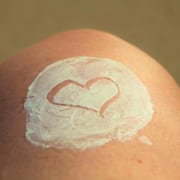Interstitial Cystitis & Perimenopause
Lana was 49 when, after being intimate with a new sexual partner, she began experiencing sharp pain around one of her ovaries.
A few days later, a severely heavy and excruciating period sent her to the emergency room. She was later diagnosed with a condition called interstitial cystitis, or IC, an inflammation or thinning of the bladder lining that can be triggered by stress and exacerbated by sex or hormonal activity.
“I had all of the above,” Lana said. “The pain precluded me from running my business (which includes travel), working out, socializing, engaging in intimacy, playing with my dog, and living my life as I had known it.”
Lana sought assistance from multiple doctors, “from urologist to gastroenterologist, along with healers from acupuncturist to shaman,” and had “every diagnostic procedure you can imagine,” she said. “The words, ‘You have a $65 co-pay’ were reverberating in my head from so much repetition,” she add. Even her father and brother, a surgeon and an anesthesiologist, couldn’t find relief for her pain.
“I took OTC pain-relievers, wore magnets, received chiropractic adjustments, even endured internal pelvic physical therapy,” she said. “Don’t ask!” After she discontinued a “painful, barbaric” urological treatment of injections into her bladder via catheter, Lana’s brother suggested she try cannabis. She had almost no experience with it, but she was willing to put her trust in her brother, who has long been involved in the industry.
“I’ve never smoked and don’t care for smoking,” Lana said, so her brother suggested a combination cannabidiol (CBD) and Delta(9)-tetrahydrocannabinol (THC) patch. “I put it on and found instant pain relief.” Combined with a natural remedy of aloe and marshmallow root supplements, along with an anti-inflammation gluten-free diet, Lana said she managed to get control over her IC. But her story doesn’t end there.
Lana sought assistance from multiple doctors, “from urologist to gastroenterologist, along with healers from acupuncturist to shaman…”
Patches of relief
According to Dr. Elaine M. Burns, ND, a patch like the one Lana uses can be a great delivery mechanism for pain management. “The route of administration with the use of a patch provides a steady stream dosing instead of an escalation/de-escalation of dose as with other routes of administration, so it does tend to be a nice form of pain management.”
According to Burns, cannabis tends to have medical benefits that are consistent across conditions “regardless of the specific condition,” and its anti-inflammatory, anti-spasmodic and mood-enhancing qualities can be used to address anything from fibromyalgia to migraines to degenerative disc disease. That adaptability turned out to be beneficial for Lana as her symptoms multiplied. Pain and frequent urination from IC led to “horrific insomnia.” Sleep deprivation led to deep depression; which, coupled with the hormonal imbalance of perimenopause, brought on anxiety.
“I was prescribed three different antidepressants, HRT (hormone replacement therapy), bioidenticals, and more supplements than you can imagine,” Lana said. She figured it was worth a try to see if the CBD/THC patches would help with those symptoms as well – and they did, especially the anxiety. “I am still struggling, but blessed with perspective, patience, a spiritual practice, and an amazing support system.” I will be forever grateful for finding these patches of relief.”
Lana says she never would have considered the patch for her perimenopause symptoms if she hadn’t had such a positive experience using them for IC pain.
Searching for a source
The patches that Lana relies on aren’t easy to obtain. She lives in a state where cannabis laws are still being hashed out. After using the patches her brother gave her, she tried to get friends in California and Colorado to send her more. “They were wary,” she said.
She was able to obtain more patches. When she ran out, Lana tried edibles, but those didn’t work for her – a patch with a 1:1 ratio of CBD to THC seemed to be ideal. “Interestingly, I get daily reminders from Walgreens to pick up one or more of the plethora of prescriptions called in,” she said. “I only wish access to the patches and other cannabis products was so easy.”
Eventually, she found Mary’s Nutraceuticals, which offers a patch “comprised primarily of CBD and very little THC for obvious reasons,” Lana says. “They are very informative and honest about contents and differences in quality along with the lack of regulation.” Even the lower-powered patch is a vast improvement. Lana can’t afford to wear them all the time, and she says they do look conspicuous, but she wears them when her IC flares up or when she needs to take the edge off her anxiety or combat insomnia. The relief, she says, is “perceptible and beyond welcome.” With it, she has been able to return to work, begin a modified workout regimen, and enjoy a normal social life.
Filling the information void
Lana says she never would have considered the patch for her perimenopause symptoms if she hadn’t had such a positive experience using them for IC pain.
“I would not have known what they were or how to procure them,” she said. “I did know that I experienced not only pain relief during the IC, but also relaxation. So I figured I had nothing to lose, only relief to gain, in trying the patches for the perimenopause symptoms as well. What a smart decision. I wish more women knew patches may provide them relief, in addition to the hormonal therapies, antidepressants, and other prescriptions meds doctors are so quick to prescribe.”
Lana says she wishes the “dearth of information” about cannabis products, their formulations, and their uses could be addressed. “I have shared my patches with two other women dealing with pain issues, and they found them to be ‘miraculous’ as well,” she said. “I have so much compassion and now hope for people dealing with all types of pain, disease, physical or emotional illness.”
Additional Reading
Interstitial Cystitis Overview – Mayo Clinic
Interstitial Cystitis Association











with these symptoms, also look at whether you’re taking birth control (it does this to some people), progesterone (10% of the population is damaged by it), Retin A (it affects the body), vitamin D pills (it’s a hormone, good and bad), and antifungal creams (mess with the body).
Thank you for this additional information!